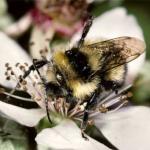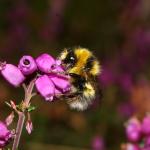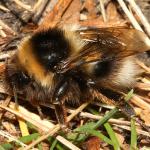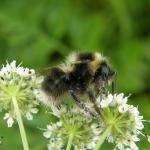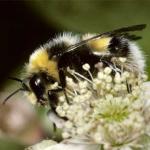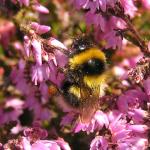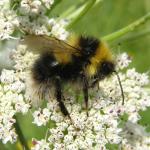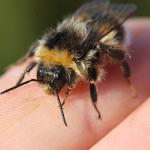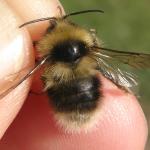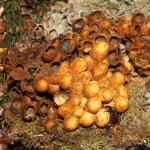Keys and general biology are found in Sladen (1912), Free & Butler (1959), Alford (1975) and Prŷs-Jones & Corbet (1991). A rather small yellow, black and white-banded bumblebee which is either expanding into habitats it was not previously found in, or has been overlooked in these areas in the past. Whilst it undoubtedly does very well on heathlands and moorlands and may be very frequent here, it is also found in calcareous grasslands, such as Salisbury Plain, coastal dunes and suburban gardens. There is a form known from the Outer Hebrides where the normally white tail is bright orange, making it look very much like B. pratorum.
This species is distributed widely throughout the entire area covered by this Atlas, although it is apparently fairly scarce in eastern England. It is widespread and often common in Europe; middle and northern latitudes of Asia, eastwards to Kamchatka (Løken, 1973).
This bee is not regarded as being scarce or threatened.
Although it has always been considered strongly associated with heathland and moorland, it does occur in a wide variety of other habitats, although it is usually less frequent in these.
In southern lowland areas B. jonellus is often bivoltine, with first-generation queens searching for nest sites in March, and males and new females are produced in May. These queens may either enter hibernation or found new nests in June. These nests produce their sexuals in late August or September. In northern and upland areas nests are not founded until June, with males in late August and September. Workers may therefore be found between April and September in southern and lowland areas, but only between July and September in northern or upland areas.
This species nests in a variety of situations, including roof-spaces; old birds' nests (usually in holes); moss and leaf-litter on the surface of the soil and underground in old mouse or vole nests. The nest is small, usually with fewer than 50 workers.
Visits are made to a very wide variety of flowers, both for pollen and nectar.
The cuckoo bumblebee Bombus sylvestris attacks nests of this species.


